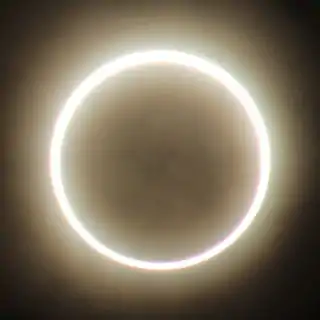Solar eclipse of November 11, 1901
An annular solar eclipse occurred on November 11, 1901. A solar eclipse occurs when the Moon passes between Earth and the Sun, thereby totally or partly obscuring the image of the Sun for a viewer on Earth. An annular solar eclipse occurs when the Moon's apparent diameter is smaller than the Sun's, blocking most of the Sun's light and causing the Sun to look like an annulus (ring). An annular eclipse appears as a partial eclipse over a region of the Earth thousands of kilometres wide. Annularity was visible from the Italian island Sicily, the whole British Malta (now Malta), Ottoman Tripolitania (now Libya), Egypt, Ottoman Empire (parts now belonging to Cretan State in Greece, Israel, Jordan and Saudi Arabia), Emirate of Jabal Shammar (now belonging to Saudi Arabia), Aden Protectorate (now belonging to Yemen), Muscat and Oman (now Oman), British Raj (the parts now belonging to India, Andaman and Nicobar Islands and Myanmar), British Ceylon (now Sri Lanka), Siam (name changed to Thailand later), French Indochina (the parts now belonging to Cambodia, southern tip of Laos and southern Vietnam, including Phnom Penh), Bombay Reef in the Paracel Islands, and Philippines.
| Solar eclipse of November 11, 1901 | |
|---|---|
 Map | |
| Type of eclipse | |
| Nature | Annular |
| Gamma | 0.4758 |
| Magnitude | 0.9216 |
| Maximum eclipse | |
| Duration | 661 sec (11 m 1 s) |
| Coordinates | 10.8°N 68.9°E |
| Max. width of band | 336 km (209 mi) |
| Times (UTC) | |
| Greatest eclipse | 7:28:21 |
| References | |
| Saros | 141 (17 of 70) |
| Catalog # (SE5000) | 9284 |
Related eclipses
Solar eclipses 1901–1902
This eclipse is a member of the 1898–1902 solar eclipse semester series. An eclipse in a semester series of solar eclipses repeats approximately every 177 days and 4 hours (a semester) at alternating nodes of the Moon's orbit.
| Solar eclipse series sets from 1898–1902 | ||||
|---|---|---|---|---|
| Ascending node | Descending node | |||
| 111 | December 13, 1898 Partial |
116 | June 8, 1899 Partial | |
| 121 | December 3, 1899 Annular |
126 | May 28, 1900 Total | |
| 131 | November 22, 1900 Annular |
136 | May 18, 1901 Total | |
| 141 | November 11, 1901 Annular |
146 | May 7, 1902 Partial | |
| 151 | October 31, 1902 Partial | |||
Saros 141
Solar saros 141, repeating every about 18 years, 11 days, and 8 hours, contains 70 events. The series started with partial solar eclipse on May 19, 1613. It contains 41 annular eclipses from August 4, 1739, to October 14, 2460. There are no total eclipses in this series. The series ends at member 70 as a partial eclipse on June 13, 2857. The longest annular eclipse occurred on December 14, 1955, with maximum duration of annularity at 12 minutes and 9 seconds. All eclipses in this series occur at the Moon’s ascending node.[1]
| Series members 17–36 occur between 1901 and 2259 | ||
|---|---|---|
| 17 | 18 | 19 |
 November 11, 1901 |
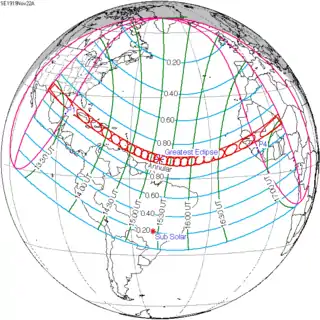 November 22, 1919 |
 December 2, 1937 |
| 20 | 21 | 22 |
 December 14, 1955 |
 December 24, 1973 |
 January 4, 1992 |
| 23 | 24 | 25 |
 January 15, 2010 |
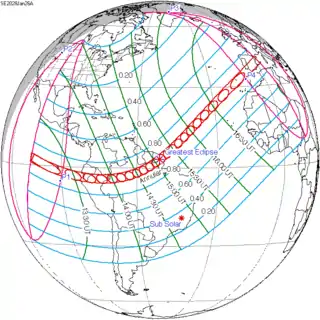 January 26, 2028 |
 February 5, 2046 |
| 26 | 27 | 28 |
 February 17, 2064 |
 February 27, 2082 |
 March 10, 2100 |
| 29 | 30 | 31 |
 March 22, 2118 |
 April 1, 2136 |
 April 12, 2154 |
| 32 | 33 | 34 |
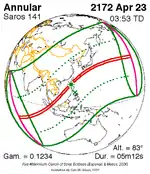 April 23, 2172 |
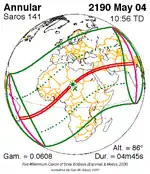 May 4, 2190 |
 May 15, 2208 |
| 35 | 36 | |
 May 27, 2226 |
 June 6, 2244 | |
Inex series
This eclipse is a part of the long period inex cycle, repeating at alternating nodes, every 358 synodic months (≈ 10,571.95 days, or 29 years minus 20 days). Their appearance and longitude are irregular due to a lack of synchronization with the anomalistic month (period of perigee). However, groupings of 3 inex cycles (≈ 87 years minus 2 months) comes close (≈ 1,151.02 anomalistic months), so eclipses are similar in these groupings.
| Inex series members between 1901 and 2100: | ||
|---|---|---|
 November 11, 1901 (Saros 141) |
 October 21, 1930 (Saros 142) |
 October 2, 1959 (Saros 143) |
 September 11, 1988 (Saros 144) |
 August 21, 2017 (Saros 145) |
 August 2, 2046 (Saros 146) |
 July 13, 2075 (Saros 147) |
||
Notes
- Saros Series Catalog of Solar Eclipses NASA Eclipse Web Site.
References
- Earth visibility chart and eclipse statistics Eclipse Predictions by Fred Espenak, NASA/GSFC
.jpg.webp)
